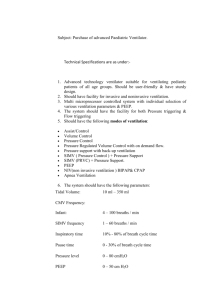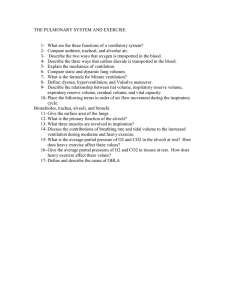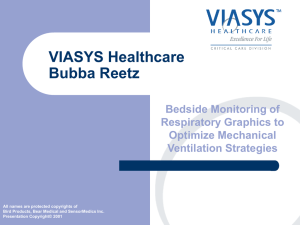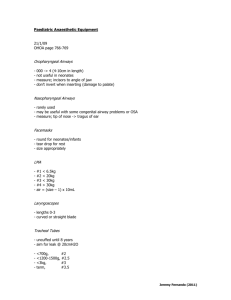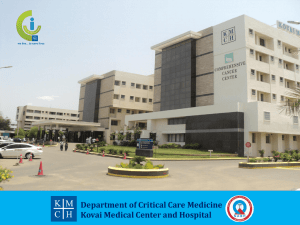Ventilator Graphics Analysis & Interpretation
advertisement
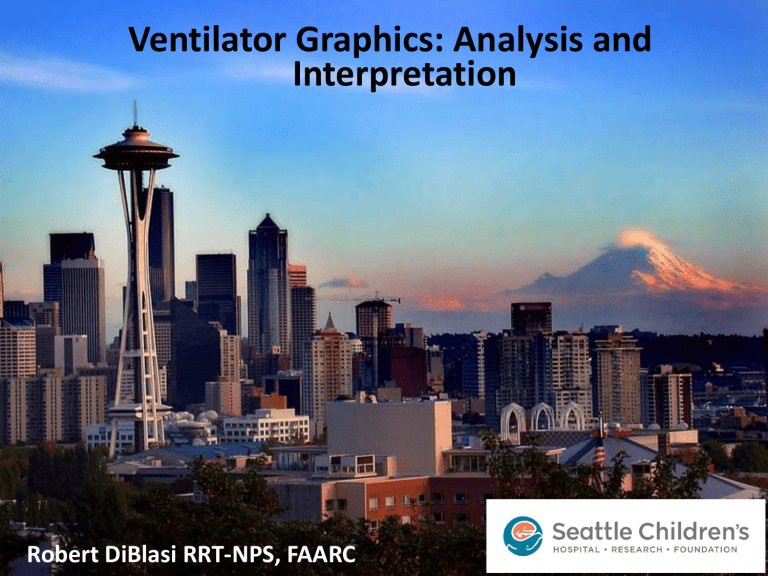
Ventilator Graphics: Analysis and Interpretation Robert DiBlasi RRT-NPS, FAARC Approaches to Invasive Ventilation 1. Know they ventilator and disease pathology 2. Develop a specific strategy for the pathophysiology in each individual patient 3. Change the ventilatory strategy as the pathophysiology changes 4. Always strive to wean the patient off of ventilatory assistance Evan Richards; Assisted Ventilation of the Neonate 4th Ed. “When in doubt, let the to kidyour makes his Listen patient! own damn ventilator changes” - Courtney Photo Courtesy of Sherry Courtney and Kaye Webber RRT The Respiratory Equation of Motion Pressure = Raw x Flow + CL/Volume Airways ET tube Lung Chest Wall What is Measured? • Real-time waveforms of – Proximal Airway Pressure – Insp. / Expiratory Flow Rate – Insp. / Expiratory Tidal Volume • Loops – Pressure / Volume – Flow / Volume Primary Goals • Early identification of processes in respiratory pathophysiology and changes in patient’s condition • Optimize ventilator performance and fine-tuning the ventilator settings • Determine the effectiveness of ventilation support • Early detection of possible adverse effects of mechanical ventilation • Minimizing the risk of ventilator-induced complications or ventilator malfunctioning Scalar Waveforms Loops Phase Variables A. Trigger: START Patient (assisted)Flow, pressure, EaDi Machine (controlled) B. Limit: TARGET Volume A Pressure EaDi C. Cycle: STOP Time Flow EaDi B A C Target variables Volume Ventilation Pressure Pressure Flow Pressure Ventilation time Flow time Phase Variables- Flow Pressure Control Inspiratory Time 0.8 s Pressure Support Flow Cycle 10% MODES Assist/Control (Controlled) Paw Paw Paw Assist Control (Assisted) Paw Paw Paw Synchronized Intermittent Ventilation (SIMV) Paw SIMV: Mandatory (patient or machine init Spontaneous breaths Paw SIMV with Spontaneous Pressure Supported Breaths Machine -Triggered (IMV) Patient -Triggered (S-IMV) Patient-triggered ventilation was associated with a shorter duration of ventilation in patients than machine-triggered modes (p=0.0134; Greenough et al.) Pressure Support Ventilation Paw Paw CPAP PS PIP increases to maintain VT with decreases in compliance PIP decreases To maintain VT with increases in compliance Pressure adjusted to maintain Vt in the face of changing compliance Neurally Adjusted Ventilatory Assist Airway Pressure Release Ventilation Abnormalities • • • • • • • • • Detection of air-leak Over-distension - Gas trapping Increased expiratory resistance Inspiratory time adjustment Airway obstruction Patient-ventilator dysynchrony Inadequate trigger sensitivity Inadequate PSV Poor Compliance Air leak- Related to ET tubes or circuit Volume Time Volume Flow Air leak- Related to ET tubes or Circuit Volume Time Volume Flow Excessive Inspiratory Time Inspiratory Time= .5 secs Excessive Inspiratory Time • Presence of inspiratory plateau • Created when Inspiratory time exceeds the time constants of the lung or when active exhalation occurs • May increase WOB and “Fighting” of the ventilator • May increase intra-thoracic pressure compromising cardiovascular status • May result in an insufficient expiratory time and gas trapping • May cause hypercarbia Excessive Inspiratory Time Flow Synchronized Ventilation • Aka “flow cycle”- allows patient to determine their own I- time by terminating the breath once a certain percentage of the peak inspiratory flow is met • May improve preload and eliminate V/Q mismatching • Improves patient/ventilator dsy-synchrony • May tremendously improve oxygenation and ventilation in spontaneously breathing patients Flow Synchronized Ventilation Flow Synchronized Ventilation Before and After Flow Cycle Added e Time Sensitivity level Flow Time Trigger Sensitivity- Appropriate Flow Trigger Selecting the proper PSV level Rise Time • May improve laminar flow of delivered breath • Assists in reducing pressure overshoot in pressure controlled and supported breaths – Increase (less aggressive flow) when: • Flow spikes are observed in initial peak flow • ETT “chatter” occurs – Decrease (more aggressive flow) when: • Compensating for leaks • Increased patient flow demand • Patient has gas trapping Rise Time- Slow Increased Expiratory Resistance • Prolonged expiratory flow indicates an obstruction to exhalation and may be caused by obstruction of a large airway, bronchospasm, or secretions Increased Expiratory Resistance Normal Resistance Elevated Resistance Insufficient Expiratory Time • Expiratory flow is unable to return to baseline prior to the initiation of the next mechanical breath • Incomplete exhalation causes gas trapping, dynamic hyper-expansion and the development of intrinsic PEEP • Can be fixed by decreasing I-time Gas Trapping with Inappropriate Inspiratory Time Inspiratory Time 0.8 s Inspiratory Time 0.4 s Forced Expiratory Flow Airway Obstruction- Secretions BEFORE SX Airway Obstruction- Secretions AFTER SX Airway Obstruction-Secretions in Sensor Stuff on Flow sensor Bronchoconstriction Bronchopulmonary Dysplasia • Former 25 wk Preemie • Ventilator dependent • Severe respiratory distress with anxiety and following bronchodilators • Bradycardia, cyanosis, hypoxia • Requiring sedation and paralytics Airway Obstruction- Tracheal Malacia Newborn Infant with a viral infection Vascular Compression Pressure Volume Curve 27 Wk Preemie; 850 grams Compliance 0.3 mL/cm H2O SIMV/PC FiO2 0.80 RR 60 PIP 26 PEEP 6 Ti 0.3 sec Tidal Volume: 6 mL/kg ABG: 7.20 / 65 / 65 / 14 Case Progression 12 hrs post-surfactant Compliance 1 mL/cm H2O SIMV/PC FiO2 0.50 RR 50 PIP 24 PEEP 6 Ti 0.3 sec Tidal Volume: 20 mL/kg ABG: 7.49 / 25 / 65 / 18 Volume Guarantee: Theory of Operation • Once placed into VG modes, a pressure breath is delivered (PEEP+5cmH2O). • Compliance is calculated and the pressure for the next breath is determined. • The next breath is delivered at 75% of the calculated pressure of the previous mandatory breath. • Each subsequent mandatory VG breath will adjust pressure (~3cmH2O) to deliver the preset VT target. • The VT target is a “minimum” value, so patients can breath above this value. Source: Klingenberg C et al. A practical guide to neonatal volume guarantee ventilation. J Perinatol. 2011 Sep;31(9):575-85 Volume Guarantee: Theory of Operation (cont'd) During periods of crying, breathing hard or gasping, the spontaneous VT may exceed the set VT. VG permits patients to take large breaths but does not augment pressure due to inbuilt safety features. Source: Klingenberg C et al. A practical guide to neonatal volume guarantee ventilation. J Perinatol. 2011 Sep;31(9):575-85 Volume Guarantee: Limitations Limitations of volume ventilation DiBlasi et al, AARC Open Forum, AARC, 2012 Esophageal Pressure Monitoring Date/ Time CRS CLung CCW Paw Plat PTPPL at PTP PEEP PEEP VT FiO2 2 (PES) 18 22 89 42 18 -3 15 500 (7/kg) 0.80 2 (PES 10 min) 16 20 90 44 20 0 19 600 0.8 2 (2 hour) 21 29 92 39 16 1 19 600 0.6 3 (24) 32 42 108118 34 14 2 19 600 0.45 3 ------(0900) --------- ------- 34 -------- ------- 17 600 0.45 3 ------(1800) --------- -------- 32 -------- ------- 15 600 0.45
